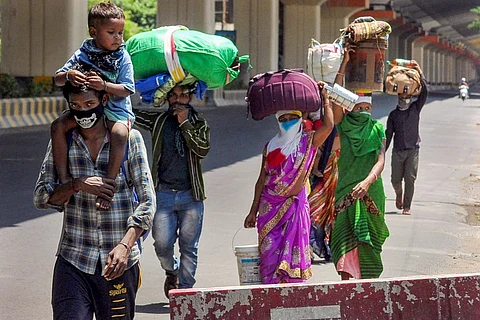

Informality is a major cause of distress in India. As of May 2021, around 2.44 crore people had tested positive for the novel coronavirus and a lockdown was imposed in different parts of the country, restricting many economic activities. India has one of the highest numbers of informal workers in the world, estimated to be between 75 to 90% of all workers. Informal workers are facing substantial economic losses due to the pandemic and subsequent lockdowns.
The second wave of COVID-19 has stalled the economic recovery of the country. According to the Centre for Monitoring Indian Economy (CMIE) data, urban unemployment touched 11.72% in the first week of May from 9.55% in the last week of April. This is more than the April monthly figure of 9.78%. In rural areas, unemployment numbers were relatively less for rural areas, but that does not mean that they are in a better place. They encounter issues such as underemployment, lower productivity, and loss of income.
The overall performance of the economy depends on both the labour and employment markets. Recently, the rating agency Moody’s slashed its FY22 growth rate in India to 9.3% from the earlier estimation of 13.7%. Urban economy has been affected tremendously due to the micro lockdowns by different states. Factory workers have been laid off. Auto rickshaw drivers are seeing a massive drop in demand. Daily wage labourers are unable to find work.
According to the ‘State of Working India 2021’ report published by Azim Premji University, Bengaluru, income and employment had not recovered to pre-pandemic levels even in late 2020, and the second wave of COVID-19 and shutting down of economies further adds to the economic distress. The report also revealed that 2 crore 30 lakh additional individuals fell below the national minimum wage poverty line. The income level of these workers is much lower in developing countries like India. If informal workers were earning enough before the pandemic, the decline in income due to sudden loss of employment might have been manageable. The depleted income levels pushed workers and their families to relative poverty as the prices of essential commodities increased drastically because of its unavailability and disruptions in supply chains. To minimise the impact of sudden loss of income, workers ended up borrowing loans at higher interest rates which ultimately led them into a vicious cycle of debt. According to a survey conducted by Action Aid Association of India on informal workers, 58% of them had to borrow money to meet their day-to-day expenses when there was no income. Thus, the life of an average urban informal worker remained highly vulnerable with no wages and precarious living standards.
Within the informal economy, women account for greater employment than men in India. Women are considered mainly for domestic work and when it comes to construction and other related sectors, they usually work as support workers. The sudden economic impact of the pandemic and the lockdown has affected their wellbeing too. Their work became more invisible, and they are more likely to lose employment as compared to men.
The first wave of the COVID-19 pandemic and subsequent lockdown has brought unprecedented hardships to the informal sector. We have seen people losing their jobs and earnings, an increase in informality, food shortage and rise in poverty and inequality. What are our learnings from the 2020 experience? Even the Union Budget 2021 did not provide any help to the millions of informal workers. In rural areas, schemes like the Mahatma Gandhi National Rural Employment Guarantee Scheme (MGNREGS) became less effective when unemployment rates increased with corresponding spikes in demand for jobs under this scheme. In April 2021, the demand for jobs under this scheme increased by 89% while the budgetary allocation for this scheme in the present fiscal is 34% less than the revised allocation in 2020-21.
In urban areas, many migrant labourers have started returning home and using up their savings in the process. The only relief in the second wave is that inter-state movement has not been restricted. On May 13, the Supreme Court expressed its concern about the health and welfare of migrant labourers during the second wave of the pandemic. The court directed the Union government to resume providing dry rations under the Atma Nirbhar Bharat scheme to all eight crore migrant labourers not covered under the National Food Security Act (NFSA) or state PDS cards.
Many informal households are unable to avail the benefits of these schemes as they do not have the documents, including ration cards. There are no proper employment contracts, social security measures or other benefits in the informal sector. Also, there exists insufficient data on informal workers, which makes policymaking even harder. Many of the government’s relief schemes, cash transfers and income support for the worst-hit informal labourers seem to be inadequate at this point of time.
Reforming the informal sector is the need of the hour. With increasing levels of unemployment in the sector, it is essential to re-employ workers. The government needs to take action to formalise the sector and to provide ample employment opportunities with proper job security and other social security benefits. Economically, the government needs to come up with policies to stimulate the demand in the economy and to overcome the current recession. There exists an urgent need to build resilience in the informal sector of the country to face the existing crisis and as well as future challenges coming their way.